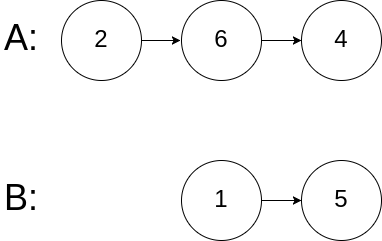160. Intersection of Two Linked Lists
Write a program to find the node at which the intersection of two singly linked lists begins.
For example, the following two linked lists:

begin to intersect at node c1.
Example 1:

Input: intersectVal = 8, listA = [4,1,8,4,5], listB = [5,0,1,8,4,5], skipA = 2, skipB = 3 Output: Reference of the node with value = 8 Input Explanation: The intersected node's value is 8 (note that this must not be 0 if the two lists intersect). From the head of A, it reads as [4,1,8,4,5]. From the head of B, it reads as [5,0,1,8,4,5]. There are 2 nodes before the intersected node in A; There are 3 nodes before the intersected node in B.
Example 2:

Input: intersectVal = 2, listA = [0,9,1,2,4], listB = [3,2,4], skipA = 3, skipB = 1 Output: Reference of the node with value = 2 Input Explanation: The intersected node's value is 2 (note that this must not be 0 if the two lists intersect). From the head of A, it reads as [0,9,1,2,4]. From the head of B, it reads as [3,2,4]. There are 3 nodes before the intersected node in A; There are 1 node before the intersected node in B.
Example 3:

Input: intersectVal = 0, listA = [2,6,4], listB = [1,5], skipA = 3, skipB = 2 Output: null Input Explanation: From the head of A, it reads as [2,6,4]. From the head of B, it reads as [1,5]. Since the two lists do not intersect, intersectVal must be 0, while skipA and skipB can be arbitrary values. Explanation: The two lists do not intersect, so return null.
Notes:
- If the two linked lists have no intersection at all, return
null. - The linked lists must retain their original structure after the function returns.
- You may assume there are no cycles anywhere in the entire linked structure.
- Your code should preferably run in O(n) time and use only O(1) memory.
给定两个链表,如果这两个链表在某个点相交,并且此后合并为一个链表,要找出这个交点;如果不想交,返回NULL。 简单的方法是,如果两个链表相交,比如题图在c1相交,则对于两个链表,从相交点往后长度是一样的,所以我们可以先求出两个链表的长度,假设长度差是delta,则较长链表先前进delta步,此时长短链表的往后的路都是一样长了,这样两个链表一起走,如果发现有相等的节点,则是相交节点,否则两个链表不相交。 本思路代码如下:
class Solution {
public:
ListNode* getIntersectionNode(ListNode* headA, ListNode* headB)
{
int len1 = 0, len2 = 0;
ListNode *h1 = headA, *h2 = headB;
while (h1) {
++len1;
h1 = h1->next;
}
while (h2) {
++len2;
h2 = h2->next;
}
h1 = headA;
h2 = headB;
if (len1 > len2) {
while (len1 > len2) {
h1 = h1->next;
–len1;
}
}
else if (len2 > len1) {
while (len2 > len1) {
h2 = h2->next;
–len2;
}
}
while (h1 && h2 && h1 != h2) {
h1 = h1->next;
h2 = h2->next;
}
if (!h1 || !h2)
return NULL;
else
return h1;
}
};本代码提交AC,用时39MS。
还有一种思路很巧妙,参考:http://www.cnblogs.com/yuzhangcmu/p/4128794.html
具体是这样的,比如题目中的例子,假设指针pA和pB分别指向A,B两个链表,两个指针同时不断的一步一步走,当pA走到结尾时,pA指向B链表表头开始走,同理当pB走到结尾时,pB指向A链表表头开始走。不断的走,当pA和pB指向同一个节点时,就是那个相交的节点。这个很巧妙呀,当pA和pB走到相交点时,他们走过的路程其实是相等的,比如题目中,他们都走了9个节点后相遇了。
代码如下:
class Solution {
public:
ListNode* getIntersectionNode(ListNode* headA, ListNode* headB)
{
if (headA == NULL || headB == NULL)
return NULL;
ListNode *h1 = headA, *h2 = headB;
ListNode *tail1 = NULL, *tail2 = NULL;
while (true) {
if (h1 == NULL)
h1 = headB;
if (h2 == NULL)
h2 = headA;
if (h1->next == NULL)
tail1 = h1;
if (h2->next == NULL)
tail2 = h2;
if (tail1 != NULL && tail2 != NULL && tail1 != tail2)
return NULL;
if (h1 == h2)
return h1;
h1 = h1->next;
h2 = h2->next;
}
}
};本代码提交AC,用时36MS。
三刷。同样的思路:
class Solution {
public:
ListNode *getIntersectionNode(ListNode *headA, ListNode *headB) {
if (headA == NULL || headB == NULL)return NULL;
ListNode *la = headA, *lb = headB;
bool la_changed = false, lb_changed = false;
while (la != lb) {
la = la->next;
lb = lb->next;
if (la == NULL) {
if (la_changed)return NULL;
else {
la = headB;
la_changed = true;
}
}
if (lb == NULL) {
if (lb_changed)return NULL;
else {
lb = headA;
lb_changed = true;
}
}
}
return la;
}
};本代码提交AC,用时68MS。